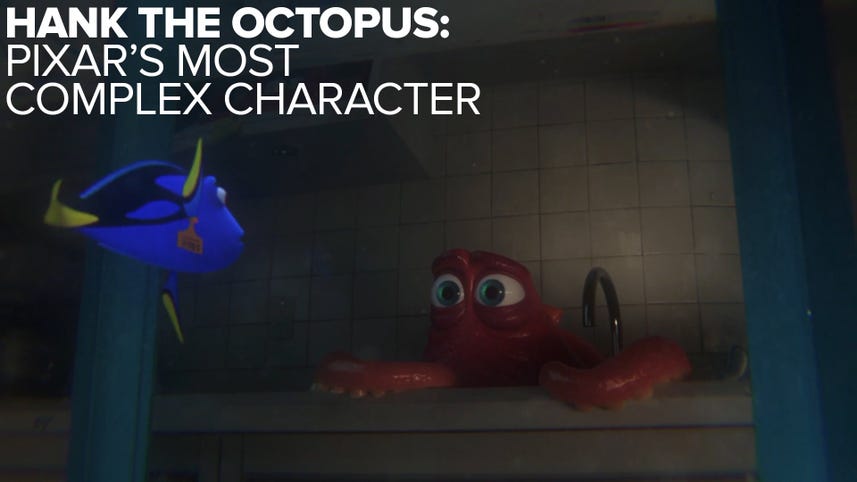
[SOUND]
Fine.
Then help me.
Hey, you.
Spinner.
Thank goodness.
Hi, I'm Dory.
The name is Hank.
[MUSIC]
So I'm a character supervisor.
We have to engineer the puppet basically that the animators use to create the performance.
Actually an engineer worked on Hank for about six months, I think.
Just figuring out how to create a new type of curve that the tentacles can use.
To make an octopus move around and squish and squash, yet make it specific enough that animators can grab any part of him and move correctly, is a problem of simplifying, breaking it apart into individual pieces and putting it back together again.
This is an octopus walking on land.
[LAUGH]
Horrifyingly.
[LAUGH] Yeah.
But there's a complexity of motion here, an aspesisity, in terms of how it interacts with the ground, how it can connect at any point and move.
My names Hank.
I have to find my family.
That's a hard one kid.
This is kind of what the art department gives us, kind of a bit of a blue
Print right.
So this is the really early version of Hank.
And the cool thing here.
What you can't see is all of these tentacles were setup slightly differently.
We kind of look at it like we're building animation that's a race car and we're giving it to them to drive.
So we gave him different configurations in each of these tentacles.
This is a simple test of can we get that like Rolling elbow, or that elbow that travels down the length that you see so much in octopus movement where the curl is actually unfurling, it's not bending like a human elbow.
And this was a real breakthrough test for us.
You can see it's starting to have that weight and flop that a tentacle, you want it to have.
It's contacting, and then releasing and sticking.
It's doing all that.
Stuff that we were challenged to build and this was about a year after we started working on it so it was a long time before we go to this point.
Glimmer.
Our friend is in there lost, alone
Baily you've got to use your echo location.
Ooh ooh ooh, I feel stupid
Poor baby lemme get that for you.
Whoo [SOUND]
It just kinda shows the flexibility interface.
It can quash, it can stretch, it can move around.
If you move a tentacle, the whole body reacts to that motion.
This is a final animation and I hid the front two tentacles and showed the controls underneath so you kinda see what it looks like underneath.
This is what kinda animators are manipulating all the time.
Here's that shot final and with that in mind you can kinda see all the The sweetening that lighting has put into shading and the shading on top of the animation and how none of us really knew.
And then the [UNKNOWN] like how they're controlling the way the suckers are interacting and the extra jiggle.
It's just really cool.
And the camouflage is really cool too.
So our shading artist, he actually applied a animated textural effect all over skin act at a very cellular level.
I don't know if you know how camouflaged an octopus can get, but it can change their color to anything, how light can interact with the texture.
Here's the final shot.
You can see the beginning.
The whole gamut.
They've got a projected texture through that camouflage that'll reveal On him and then you'll see all that drippy squishy motion that we worked so hard on and then you know, the animators spent a long time on this shot.
I think this shot, from when we started to when this shot was finaled I think it was two years.
This was a big scene?
Yeah, because this was one of the first shots they put into production, so I think
The first shot was finalized two yeas after we'd started the project.
That's a lot of blood sweat and tears.
Yeah.
From a lot of people.
Dory, you're about to find your parents.
And when you do that, you'll be
Home.
[Music]